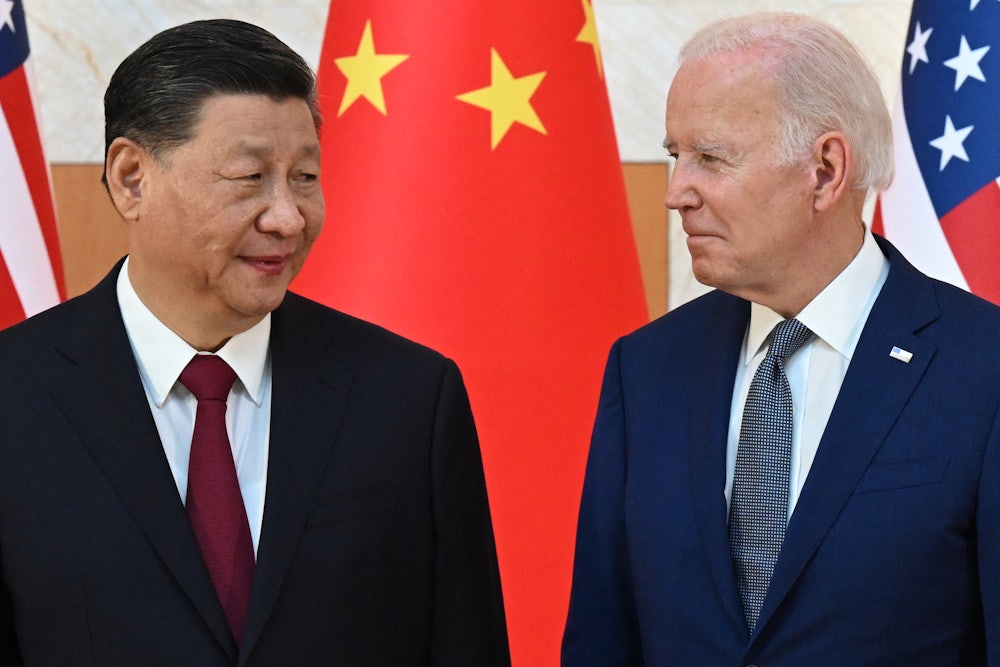“There’s an old joke,” Woody Allen says at the start of his 1977 movie Annie Hall. “Two elderly women are at a Catskill mountain resort. And one of them says, ‘Boy the food at this place is really terrible.’ The other one says, ‘Yeah, I know. And such small portions.’”
That Borscht Belt witticism neatly sums up the Biden administration’s new trade policy, with the president speaking both parts.
The food at this place is really terrible: That’s candidate Joe Biden during the 2020 campaign, lambasting President Donald Trump’s tariffs on three-quarters of all Chinese imports:
Trump doesn’t get the basics. He thinks his tariffs are being paid by China. Any beginning econ student at Iowa or Iowa state could tell you that the American people are paying his tariffs. The cashiers at Target see what’s going on—they know more about economics than Trump.
And such small portions: That’s President Biden keeping in place Trump’s supposedly awful China tariffs—and, this week, increasing them dramatically, especially for electric vehicles (Trump’s 25 percent tariff will rise to 100 percent), lithium-ion batteries (from 7.5 percent to 25 percent), and solar cells (from 25 percent to 50 percent). These are large portions indeed. If Trump’s China tariffs were Trade War One, Biden’s are Trade War Two. This second war is more strategically sound and stands a better chance of success. But it makes me uneasy.
Trade War One was a bust. In a memorable May 2022 essay in The Wall Street Journal, Bob Davis and Lingling Wei pointed out that China continues to do all the things that Trade War One was meant to end. China still subsidizes industries to a degree that puts U.S. competitors at a disadvantage. China still overproduces goods. And China still steals every trade secret that isn’t nailed down. Although Trade War One was supposed to create American jobs, the U.S.-China Business Council calculated that, at its peak, Trade War One eliminated 245,000 American jobs. Trade War One also probably helped create the inflationary surge in 2021.
During Trade War One, America’s trade deficit with China shrank, but its overall trade deficit grew as other nations stepped into the breach. Like the Tommies and the Jerries mired on the Western front, the United States and China stalemated. The real winner of Trade War One, the Journal’s Davis and Wei concluded, was Vietnam, which increased exports to the United States by the same $50 billion that China reduced them.
China’s refusal to change its behavior left the incoming Biden team with a Hobson’s choice: Surrender or stay the course. For three years Biden stayed the course; now he’s escalating. The stated impetus is to protect his $860 billion investment in developing green technologies through the infrastructure law, the CHIPS Act, and the Inflation Reduction Act. Given the Chinese lead on manufacturing electric vehicles and solar panels, trade protection may be necessary to develop an American market.
But of course Trade War Two is at least as much a war between Biden and Trump as it is a war between the United States and China. A fact sheet on the new policy notes acidly that the previous administration’s China policy “failed to increase American exports or boost American manufacturing, as it had promised.” A January 2024 paper by economists David Autor of MIT, Anne Beck of the World Bank, David Dorn of the University of Zurich, and Gordon Hanson of Harvard noted that although Trump’s trade war “has not to date provided economic help to the US heartland,” it was a great political success there, making Republican voters out of Democrats in 2020. These manufacturing regions are the same places Biden must win in order to secure reelection. Trump has now upped the stakes by proposing a 60 percent tariff on all Chinese imports and a 10 percent tariff on imports from every other country. This without question would be inflationary (though Trump, preposterously, denies that). As details of Biden’s plan leaked out this past weekend, Trump pledged to put a 200 percent tariff on any cars China may soon manufacture in Mexico.
As policy, Trade War Two will have some perverse effects. It will help enlarge the domestic industry in electric vehicles by effectively barring Chinese E.V.s. Chinese E.V.s are not yet a significant part of the U.S. market, and under the new policy they never will be. But protection could easily create a domestic monopoly. Elon Musk’s Tesla already controls the majority of the domestic market in electric vehicles; now Musk will no longer have to worry about losing market share to China. In addition, the 100 percent tariff on Chinese E.V.s will raise prices for other E.V.s, which will in turn slow domestic adoption of the very technology Biden’s trying to spread to combat the climate change emergency.
The main thing Trade War Two will achieve is an end to a half-century of trade liberalization. Davis pointed out to me that whenever the G20 meets, this group of leaders from the planet’s 20 largest economies renews its commitment “to ensure a level playing field and fair competition by discouraging protectionism.” “I can’t imagine,” Davis told me, that this boilerplate will survive in future G20 statements. I’m not yet on board with the new economic doctrine that says the desire for more open markets is an artifact of the bad old neoclassical order, and good riddance to it. I fear these trade wars will never end. I hope I’m wrong.






